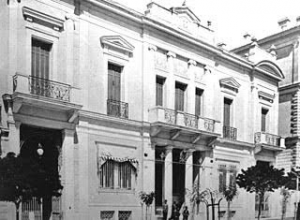It is the largest -outside of the tourist real estate market- and is now an innovative investment that is being launched, with private funding, right now in the heart of the center of Athens, aiming to bring an air of modern megacities to Greek capital.
Within 10,000 square meters, a history of almost 140 years is being “married” with modern architecture and in an attempt to rescue one of the few remaining jewels of the center. The ship-owning family Prokopiou, known investors of the domestic real estate market, want to create at 50 Stadiou Street, the first big incubator for businesses and a place of multipurpose venues to work and recreation through an investment totaling € 10 million.
This is the first time that an organized effort is made for a ruined, but a historic monument, such as the Palace Athinogenes, to be transformed into a totally modern space, based on the international trends and beyond the ordinary, that is to say its transformation into a hotel following the investment frenzy recently seen in the industry due to the rise of tourism in Athens or into a department store.
The ambitious project, has many common elements with the one launched by the US company “We Work” just in the beginning the decade, when the collapse of the real estate market and the fall of prices, after the Lehman Brothers season, brought a great opportunity for its founders: It was 2010 when Adam Neumann and Miguel Mc Kelvey created, precisely because of lower rents in their New York City first, state-of-the-art technologically and more human spaces of work for individual workers, freelancers, small businesses, startups and larger companies. Today “We Work”, with that is worth more than $20 billion, has now been expanded to 58 cities around the world in America, Europe and Asia, and very recently, just last August, secured a $ 4.4 billion deal for the entry in the parent company’s shared capital of the Japanese company Softbank and Vision Fund, but also in three subsidiaries (WeWork China, WeWork Japan and WeWork Pacific) for further expansion to Asia.
The Athenogenous Mansion (Megaron)
“The role of investors is not only to see but also to create prospects. The new hotels that have been created over the past two years and are still being created, around the Syntagma Square, the Metropoleos str., but also Omonoia and Karaiskaki Squares, lead in that direction, but they cannot alone do enough. In the Greek capital 85% of buildings are in need of modernization due to age. Other innovative projects are needed to bring new light to the center and now, the fall in prices, due to the crisis in the real estate market as well, seems to create more mature conditions”.
The viability of such an approach dictates the erection of a new building volume on the back of the plot creating with the Mansion a dynamic building complex in the urban fabric of its center city, highlighting its architectural richness”. The latest developments have to do with the “green light” the Ministry of Culture gave this summer for the studies (architecture, static and electromechanical installations) of the restoration of the Mansion.
On Stadiou Street 50, the new building to be built should responds in the best way to a series of difficult requirements such as respect and design linking organically to the existing building, as mentioned in relative study, “with a timeless work of art”.
The history
The history of the Athenogenous Megaron goes back to the 19th century, between the time 1875-1880 when it was built on the basis of plans by a foreign architect who worked in Greece (there is a dichotomy if it is about Piat or Eisen Trumb, while a floor plan is also found in the Ziller file). The building belonged to an old Athenian family, the Athinogenous family, and at the end of the 19th century it housed for a while the Ottoman Bank (Banque Ottomane de Change et de Valeurs), one of the most important financial institutions of the time.
The Athenogenous Mansion is the only building that has survived an informal “Trilogy” with Megara Vouros (Stadium and Syntagma Square, where the Athens Plaza Hotel is currently located) and Skouloudi (where King George Hotel was built later, also in Syntagma). The three buildings residences, equal number of eminent men of the newly established, then, Athenian, urban class, representing the Greek capital, were built in the latter decades of the 19th century and have a congenital morphology, an alloy of Attic classicism with many French neo-baroque influences.
From 1971 to 2008, Athenogenous was in a state of disrepair:
In 1971 the building fell into a ruinous state and the “Historic and Ethnological Company” got its ownership, while in 1977, after a storm, it suffered serious damage and large pieces even from the facade and the interiors they fell down. After the removal of the dangerous parts and the temporary fixings, the earthquake 1981 caused new serious damage, resulting in the building being judged by structural and static experts as dangerous. In 1995, the building was classified as “historic preserved monument and work of art, because it is a notable sample of neoclassical manor house, harmonizing Baroque elements, important for the evolution of the history of the architecture of Athens “. One more blow, the last one for the building, which like mentioned above, is in danger of collapsing today, was the fire that destroyed its interior in May 2004. In 2008, at the request of its new owners, a Commission was set up to examine the preservable building, while its main concern was -and remains- its protection and its overall treatment in a sustainable and efficient way to the city.
Ask me anything
Explore related questions










